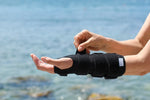
How to Choose the Best Wrist Brace for Your Needs
, by OrthOut Writer, 8 min reading time

, by OrthOut Writer, 8 min reading time
In this guide, we walk you through key factors to consider when selecting the best wrist brace for optimal comfort, pain relief, and healing.
Wrist braces are designed to support recovery and help relieve pain for many different conditions. However, with so many options available, choosing the right orthopedic wrist brace can be overwhelming. In this guide, we walk you through key factors to consider when selecting the best wrist brace for optimal comfort, pain relief, and healing.
Wrist pain can be debilitating, interfering with daily activities and your overall well-being. A well-chosen wrist brace can provide essential support, alleviate discomfort, and aid in recovery.
From determining sizing to understanding support levels, read on to explore everything you need to know to find the ideal wrist brace for optimal comfort and healing.

A properly sized brace provides the necessary support to the wrist, helping to prevent further complications, reduce pain, and facilitate healing. An ill-fitting wrist brace can cause irritation or discomfort and compromise the healing process.
Here are some important factors to keep in mind when determining the best size and fit of a wrist brace:
The material of a wrist brace significantly impacts its effectiveness and comfort. The severity of an injury, the required level of support, and personal preferences will all help determine the best brace material for your specific needs.
Here are some key considerations for wrist brace materials:

The severity of your wrist injury or condition will determine the level of support needed. A mild sprain might require a lightweight support wrap, while a fracture might necessitate a rigid immobilization brace. Always consult with a healthcare professional to determine the appropriate support level for your specific needs.
For mild conditions, a wrist sleeve or a wrist wrap can help reduce pain and inflammation to promote recovery.
For conditions like chronic pain, arthritis, Carpal Tunnel, tendonitis, and sprains, adjustable wrist braces can provide moderate support when you need it most.
If you’re recovering from surgery or an injury, recently got a cast removed, or are experiencing chronic pain, a rigid wrist brace or a stabilizer brace can offer maximum support.
There are many different types of wrist braces available, each designed for specific purposes, conditions, and support levels. Your injury or condition will be the biggest determining factor in choosing the best type of wrist brace for your needs.
Below, we list some common types of wrist braces and what they are generally used to treat.
A wrist sleeve provides targeted support to reduce pain, inflammation, and accelerate the body’s natural healing process. Sleeves like the Incrediwear Wrist Sleeve are made from a breathable and moisture wicking fabric, and are used to improve blood flow, soothe pain, and reduce swelling.
Wrist sleeves offer mild support and can help alleviate symptoms associated with:
Wrist wraps offer adjustable support using Velcro straps which make them easy to take on and off. A great example is the Hely & Weber Gel Wrist Wrap, which is made from neoprene, which is a soft and comfortable compression fabric. It also features a contoured gel pad infused with vitamin E mineral oil to support scar maturation, absorb shock, and soothe pain.
Wrist wraps offer mild to moderate support and help alleviate symptoms associated with:
Rigid wrist braces offer the highest level of support and immobilization. They are typically made from a supportive fabric and incorporate a hard plastic or metal component (stays) for added support and movement restriction.
A great example of this is the Hely & Weber Titan Wrist Brace. This rigid wrist brace features removable palmar and dorsal stays, which is a popular option for “step-down” rehabilitation.
Ridgid wrist braces offer maximum support and are often used for:
A thumb stabilizer brace is designed to immobilize the thumb at the base of the palm, while still allowing free movement of your other fingers. For instance, the Hely & Weber CMC Controller Plus thumb brace provides effective pain relief and stability without interfering with everyday activities.
A thumb stabilizer brace offers moderate to maximum support and is commonly used to treat:
Whether you’re searching for daily support or recovering from an injury, finding the best wrist brace for your specific needs is essential. At Orthopedic Outfitters, we have decades of experience providing the best orthopedic physical therapy products to both clinicians and consumers. Take your recovery to the next level by browsing our selection of orthopedic braces today.
Plus, get FREE shipping on all orders over $50!
Shop All Orthopedic Wrist Braces >>>